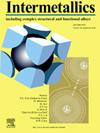First-order reversal curve analysis of rapid-solidified Co78Zr17B2Si1M2 (M= W, Cr, Mo) alloys
IF 4.3
2区 材料科学
Q2 CHEMISTRY, PHYSICAL
引用次数: 0
Abstract
This research focuses on first-order reversal curve (FORC) analysis of rapid-solidified Co78Zr17B2Si1M2 (M = W, Cr, Mo) alloys. In this regard, vacuum arc melting and melt-spinning techniques were used to prepare the initial samples and the annealing process was carried out at temperature range of 400–700 °C. The prepared samples were analyzed using X-ray diffractometer (XRD), field emission scanning electron microscopy (FESEM) and FORC analysis. Based on the obtained results from the FORC analysis, the structure of Co78Zr17B2Si1M2 (M = W, Cr, Mo) alloys after melt spinning process was combination of Co5Zr and amorphous phase. The optimum annealing temperature to achieve the best hard magnetic properties was shown to be 400 °C as a result of the formation of a single-phase compound of Co5Zr. The alloy containing Cr showed the highest coercivity (about 4.6 kOe), and the maximum coercivity for samples containing Mo and W was estimated to be about 3.4 kOe and 3.2 kOe, respectively.
快速凝固的 Co78Zr17B2Si1M2(M= W、Cr、Mo)合金的一阶反向曲线分析
本研究的重点是对快速凝固的 Co78Zr17B2Si1M2(M = W、Cr、Mo)合金进行一阶反向曲线(FORC)分析。研究采用真空电弧熔炼和熔融纺丝技术制备初始样品,并在 400-700 °C 温度范围内进行退火处理。制备的样品使用 X 射线衍射仪(XRD)、场发射扫描电子显微镜(FESEM)和 FORC 分析仪进行分析。根据 FORC 分析的结果,Co78Zr17B2Si1M2(M = W、Cr、Mo)合金在熔融纺丝后的结构是 Co5Zr 和非晶相的组合。由于 Co5Zr 单相化合物的形成,获得最佳硬磁特性的最佳退火温度为 400 ℃。含有铬的合金显示出最高的矫顽力(约 4.6 kOe),而含有钼和钨的样品的最大矫顽力估计分别约为 3.4 kOe 和 3.2 kOe。
本文章由计算机程序翻译,如有差异,请以英文原文为准。
求助全文
约1分钟内获得全文
求助全文
来源期刊

Intermetallics
工程技术-材料科学:综合
CiteScore
7.80
自引率
9.10%
发文量
291
审稿时长
37 days
期刊介绍:
This journal is a platform for publishing innovative research and overviews for advancing our understanding of the structure, property, and functionality of complex metallic alloys, including intermetallics, metallic glasses, and high entropy alloys.
The journal reports the science and engineering of metallic materials in the following aspects:
Theories and experiments which address the relationship between property and structure in all length scales.
Physical modeling and numerical simulations which provide a comprehensive understanding of experimental observations.
Stimulated methodologies to characterize the structure and chemistry of materials that correlate the properties.
Technological applications resulting from the understanding of property-structure relationship in materials.
Novel and cutting-edge results warranting rapid communication.
The journal also publishes special issues on selected topics and overviews by invitation only.
 求助内容:
求助内容: 应助结果提醒方式:
应助结果提醒方式:


